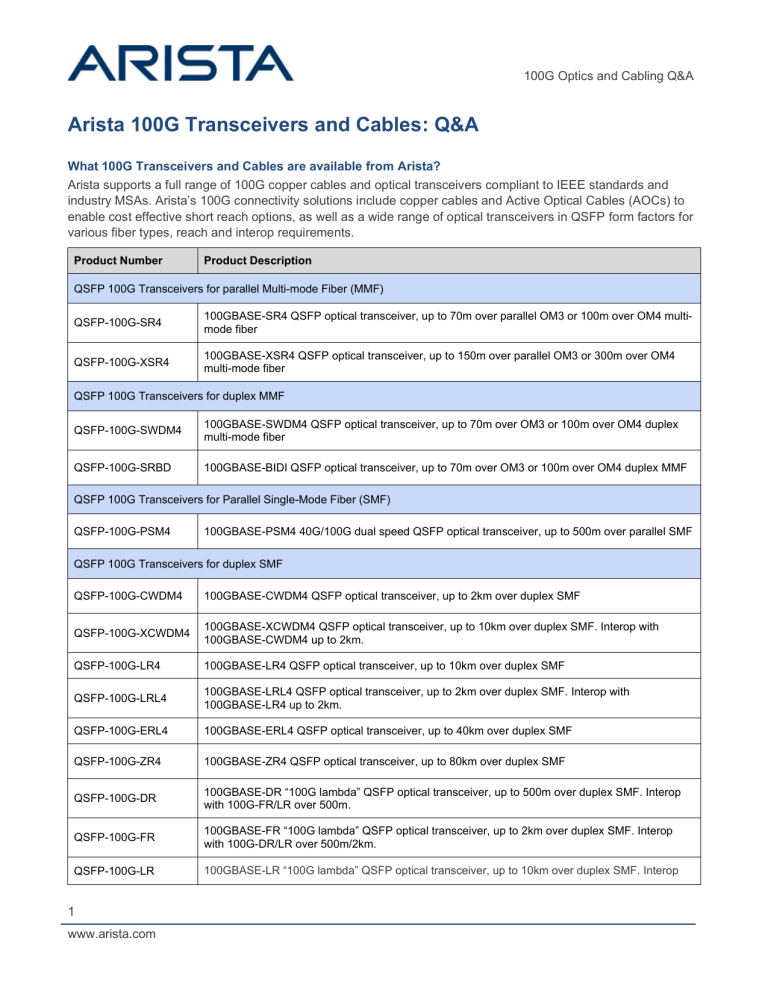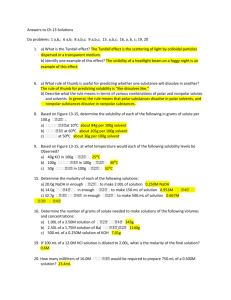Arista 100G Optics & Cabling Q&A: Transceivers & Cables Guide
advertisement

100G Optics and Cabling Q&A Arista 100G Transceivers and Cables: Q&A What 100G Transceivers and Cables are available from Arista? Arista supports a full range of 100G copper cables and optical transceivers compliant to IEEE standards and industry MSAs. Arista’s 100G connectivity solutions include copper cables and Active Optical Cables (AOCs) to enable cost effective short reach options, as well as a wide range of optical transceivers in QSFP form factors for various fiber types, reach and interop requirements. Product Number Product Description QSFP 100G Transceivers for parallel Multi-mode Fiber (MMF) QSFP-100G-SR4 100GBASE-SR4 QSFP optical transceiver, up to 70m over parallel OM3 or 100m over OM4 multimode fiber QSFP-100G-XSR4 100GBASE-XSR4 QSFP optical transceiver, up to 150m over parallel OM3 or 300m over OM4 multi-mode fiber QSFP 100G Transceivers for duplex MMF QSFP-100G-SWDM4 100GBASE-SWDM4 QSFP optical transceiver, up to 70m over OM3 or 100m over OM4 duplex multi-mode fiber QSFP-100G-SRBD 100GBASE-BIDI QSFP optical transceiver, up to 70m over OM3 or 100m over OM4 duplex MMF QSFP 100G Transceivers for Parallel Single-Mode Fiber (SMF) QSFP-100G-PSM4 100GBASE-PSM4 40G/100G dual speed QSFP optical transceiver, up to 500m over parallel SMF QSFP 100G Transceivers for duplex SMF QSFP-100G-CWDM4 100GBASE-CWDM4 QSFP optical transceiver, up to 2km over duplex SMF QSFP-100G-XCWDM4 100GBASE-XCWDM4 QSFP optical transceiver, up to 10km over duplex SMF. Interop with 100GBASE-CWDM4 up to 2km. QSFP-100G-LR4 100GBASE-LR4 QSFP optical transceiver, up to 10km over duplex SMF QSFP-100G-LRL4 100GBASE-LRL4 QSFP optical transceiver, up to 2km over duplex SMF. Interop with 100GBASE-LR4 up to 2km. QSFP-100G-ERL4 100GBASE-ERL4 QSFP optical transceiver, up to 40km over duplex SMF QSFP-100G-ZR4 100GBASE-ZR4 QSFP optical transceiver, up to 80km over duplex SMF QSFP-100G-DR 100GBASE-DR “100G lambda” QSFP optical transceiver, up to 500m over duplex SMF. Interop with 100G-FR/LR over 500m. QSFP-100G-FR 100GBASE-FR “100G lambda” QSFP optical transceiver, up to 2km over duplex SMF. Interop with 100G-DR/LR over 500m/2km. QSFP-100G-LR 100GBASE-LR “100G lambda” QSFP optical transceiver, up to 10km over duplex SMF. Interop 1 www.arista.com 100G Optics and Cabling Q&A with 100G-DR/FR over 500m/2km. 100G QSFP Active Optical Cables AOC-Q-Q-100G-xM 100GbE QSFP to QSFP Active Optical Cable, 1m to 30m 100G QSFP Twinax Copper Cables CAB-Q-Q-100G-xM 100GBASE-CR4 QSFP to QSFP Twinax Copper Cable, 0.5m to 5m CAB-Q-4S-100G-xM 100GBASE-CR4 QSFP to 4 x 25GbE SFP Twinax Copper Cable, 1m to 5m What is the difference between QSFP28 and 100G QSFP? They are the same. The “QSFP” form factor was originally defined for <10G speeds. When it was adopted for 40G, the name became QSFP+ to denote the higher aggregate performance. The same “QSFP” form factor was later adopted for 100G but the electrical interface had to be upgraded to handle 25Gbps/lane. The electrical interface for 100G can handle up to 28Gbps, hence the engineering and industry name is QSFP28. Arista refers to the 100G form factor as “100G QSFP” to avoid any confusion. Which 100G QSFPs are capable of supporting link distances over 10km? The Arista QSFP-100G-ZR4 supports link distances up to 80km. A minimum of 12dB attenuation is required to prevent permanent damage to the receiver - refer to the optics datasheet for optical specs. The QSFP-100G-ZR4 is supported on a limited set of platforms – refer to the Transceiver and Cable Guide for supported platforms. The Arista QSFP-100G-ERL4 supports link distances up to 40km when the forward error correction (FEC) is enabled on the host switch / router. In the default no-FEC mode, QSFP-100G-ERL4 supports a reach of up to 30km. A minimum of ~10dB attenuation is required to guarantee the receiver is not damaged. Please refer to the optics datasheet for optical specifications. The QSFP-100G-LR4 supports links up to 10km over duplex single mode fiber. Enabling FEC with QSFP-100GLR4 optics on Arista switches can allow for links beyond 10km with single mode fiber. However, as this is not fully characterized, customers are advised to measure the link distance and optical loss budget before deploying. Are 100G copper cables supported on all Arista switches? Most Arista switches support the use of copper cables, with a few exceptions which are listed below. Please refer to the individual switch datasheets for a comprehensive list of media types supported. Arista Switch Ports 7280SRAM-48C6 48 x SFP+ and 6 x QSFP100 with MACsec 7280CR2M-30 30 x QSFP100 with MACsec 7500RM-36CQ 36 x QSFP100 with MACsec 7500R2M-36CQ 36 x QSFP100 with MACsec 7500R2AM-36CQ 36 x QSFP100 with MACsec 2 www.arista.com Copper cable restrictions Copper cables (100GBASE-CR4 and 40GBASE-CR4) are not supported on the QSFP100 ports. 100G Optics and Cabling Q&A What industry standards are associated with each of the 100G Transceivers and Cables? The table below summarizes the Arista 100G transceivers and cables and the associated industry standards. Product Number Associated Industry Standard QSFP-100G-SR4 IEEE 802.3 100GBASE-SR4 QSFP-100G-XSR4 Based on IEEE 802.3 100GBASE-SR4, with extended reach QSFP-100G-SWDM4 SWDM Multi-Source Agreement (MSA): http://www.swdm.org/msa QSFP-100G-PSM4 100G PSM4 MSA: http://psm4.org/ QSFP-100G-CWDM4 and QSFP-100G-XCWDM4 CWDM4 MSA: http://www.cwdm4-msa.org/ QSFP-100G-LR4 IEEE 802.3 100GBASE-LR4 QSFP-100G-LRL4 Based on IEEE 802.3 100GBASE-LR4, with shorter reach. Compatible with LR4 up to 1km. QSFP-100G-ERL4 Based on IEEE 802.3 100GBASE-ER4, with reach up to 30km. QSFP-100G-DR IEEE 802.3 100GBASE-DR QSFP-100G-FR and QSFP-100G-LR 100G Lambda MSA: https://100glambda.com/ AOC-Q-Q-100G-yM Based on IEEE 802.3 100GBASE-SR4, with pre-terminated cables CAB-Q-Q-100G-yM IEEE 802.3 100GBASE-CR4 Are there any 100G transceivers that allow the use of standard duplex multi-mode fiber? Yes – Arista offers two 100G transceivers that operate over duplex multimode fiber: The QSFP-100G-SWDM4, and the QSFP-100G-SRBD (or “BIDI”) transceiver. What is the 100G SWDM4 transceiver? The QSFP-100G-SWDM4 provides 100Gbps bandwidth over a standard duplex multi-mode fiber eliminating the need for expensive parallel multi-mode fiber infrastructure and offers a seamless migration path from duplex 10G/40G to 100G. It is supported on all Arista QSFP 100G ports and can be used for links up to 70m of OM3 fiber or up to 100m of OM4 fiber. The SWDM4 Tx port transmits 100G data over 4 x 25Gbps wavelengths, and the Rx port receives data over 4 x 25Gbps wavelengths. The wavelengths are in the “short wavelength” range (850nm – 940nm). 3 www.arista.com 100G Optics and Cabling Q&A What is the 100G-SRBD (or “BIDI”) transceiver? Like the QSFP-100G-SWDM4 transceiver described above, the Arista QSFP-100G-SRBD transceiver also provides 100Gbs bandwidth over standard duplex multi-mode fiber. However, unlike the SWDM4 transceiver (which transmits 4 x 25Gbps wavelengths out of the Tx port, and receives 4 x 25Gbps wavelengths on the Rx port), each optical port on the SRBD contains both a transmitter and receiver, running at full duplex 50Gb/s over a single fiber. The two ports of the QSFP-100G-SRBD provide an aggregate 100Gb/s of bandwidth. The QSFP100G-SRBD is supported on all Arista QSFP 100G ports, and can be used for links up to 70m of OM3m or up to 100m of OM4 multi-mode fiber. Both the 100G-SWDM4 and the 100G-SRBD transceivers support 100G over duplex multi-mode fiber. When should each transceiver be used? Both the 100G-SWDM4 and 100G-SRBD (sometimes called a “BIDI” transceiver) have been widely deployed within the industry, and share the same optical reach and fiber type (70m/100m over OM3/OM4 duplex MMF). However, the 100G-SWDM4 and 100G-SRBD do not interoperate with each other. The decision on which optic to use will largely depend on interop requirements. For example, for applications that require optical interop with third party 100G BIDI optics, the QSFP-100G-SRBD should be used. Are Arista 100G Transceivers interoperable with other 100G transceivers available in the industry? Yes, as long as the non-Arista 100G transceivers meet the associated industry standard specifications, Arista 100G transceivers are fully interoperable. Can 100G QSFP interfaces interoperate with SR10 based 100GbE? No. The 100G QSFP form factor has just 4 electrical lanes, which is not enough to support 10 lanes of 10G electrical interface. A 100G QSFP can only support a 4x10G or 4x25G electrical interface, which can be used as 4x10GbE or 4x25GbE, but not 10x 10GbE.. As a result the 100G QSFP SR4 cannot interoperate with SR10 based 100GbE transceivers. A complex design with a reverse gearbox (4x25G to 10x10G) can achieve this but results in expensive and power hungry optics. Can 100G QSFP copper cables be used for 40G? Yes, Arista 100G QSFP copper cables can be used for 40G, but not vice versa. Can Arista 40G QSFPs be used in Arista 100G QSFP switch ports? Yes, 40GbE QSFP+ transceivers will be detected and enabled upon insertion. Are there any dual speed 100G/40G optics to avoid costly replacement when I upgrade? The QSFP-100G-CWDM4 (up to 2km over duplex SMF) and QSFP-100G-PSM4 (up to 500m over parallel SMF), are dual-rate optics which be used in both 40G and 100G modes. 4 www.arista.com 100G Optics and Cabling Q&A Which Arista 100G Transceivers and Cables can be used in breakout mode? Breakout mode refers to running a 100G port as 4 separate channels of 25GE. Transceivers or copper cables that enable optical or electrical breakout allow one 100G QSFP100 port to connect to four physically separate 25G links. When breaking out a single 100G port to 4x 25G links, care must be taken to use the same Forward Error Correction (FEC) mode on both ends of the link to ensure link-up. Arista transceivers and copper cables that support 100G to 4x25G breakout are listed below. Product Number Supported Breakout modes QSFP-100G-SR4 & QSFP-100G-XSR4 4x25G to interoperate with 25GBASE-SR. Care must be taken to use the same forward error correction (FEC) mode on both ends to link-up. QSFP-100G-PSM4 4x25G to interoperate with 25GBASE-LR. Care must be taken to use the same forward error correction (FEC) mode on both ends to link-up. CAB-Q-4S-100G-xM 4x 25G Copper breakout cable (using a 100G QSFP to 25G SFP), lengths from 1m to 5m What is the maximum power consumption of 100G QSFP transceivers? The table below summarizes the power consumption of Arista 100G QSFP transceivers. Product Number Max Power Consumption QSFP-100G-SR4 / XSR4 QSFP-100G-SWDM4 QSFP-100G-SRBD QSFP-100G-CWDM4 / XCWDM4 QSFP-100G-PSM4 AOC-Q-Q-100G-xM (1m to 30m) 3.5W QSFP-100G-LRL4 4.0W QSFP-100G-LR4 QSFP-100G-ERL4 QSFP-100G-DR QSFP-100G-FR QSFP-100G-LR 4.5W QSFP-100G-ZR4* 5.5W * The QSFP-100G-ZR4 is supported on specific platforms because of the higher power draw. Please refer to the Arista Transceivers and Cables Guide for Supported Platforms. What will happen if I plug in 100G QSFP transceivers that consume greater than 3.5W? Unless otherwise specified in product datasheets, all Arista 100G QSFP ports are designed to handle QSFP transceivers that draw up to 4.5W. If a 100G QSFP draws greater than 4.5W Arista cannot guarantee the performance since there are other dependencies like airflow direction, ambient temperature, elevation etc. If a QSFP optic requires more than 3.5W, it must identify accordingly and draw only up to 3.5W at initial insertion to avoid overloading a host system. The system will then determine if the higher power optic is supported and will enable the high power mode accordingly. If high power optics do not follow the specification caution should be taken to avoid the risk of damage to the equipment. 5 www.arista.com 100G Optics and Cabling Q&A What are “100G Lambda” Optics? “100G Lambda” or “Single Lambda” optics are optical transceivers that have an optical output consisting of a single 100G PAM-4 optical signal. The Arista 100G “Single Lambda” SKUs are: • • • QSFP-100G-DR: 100GBASE-DR single lambda QSFP, up to 500m over duplex SMF. QSFP-100G-FR: 100GBASE-FR single lambda QSFP, up to 2km over duplex SMF. QSFP-100G-LR: 100GBASE-LR single lambda QSFP, up to 10km over duplex SMF. The 100G-DR/FR/LR transceivers can be plugged into any Arista 100G QSFP port. The electrical connector interface is 4 x 25G NRZ – the same as all existing ‘legacy’ 100G QSFP modules. The optical output is a single wavelength (or “lambda”) 100Gbit/s PAM-4 optical signal. The 100G-DR/FR/LR modules include a gearbox chip to convert the 4 x 25G NRZ electrical signals to a 1 x 100G PAM-4 optical signal. This is in contrast to legacy QSFP100 modules (such as a CWDM4 or LR4 100G module), which have 4 x 25G NRZ optical wavelengths multiplexed onto one fiber. Because of the different optical modulation scheme, 100G-DR / FR / LR modules will not interoperate with legacy 100G modules (such as CWDM4, LR4 etc), but they will interop with 400G-DR4 and 400G-XDR4 modules using breakout cables. Please refer to the 400G FAQ for more details about 400G to 4x 100G breakout options. The difference in optical modulation schemes between legacy 100G QSFP modules, and a 100G-DR / FR / LR module is illustrated below. 6 www.arista.com 100G Optics and Cabling Q&A What optical fiber type is needed for 100G Transceivers? The table below details the connector type of each 100G Transceiver and the cable type to be used. Product Number Optical Connector Fiber Type to be used QSFP-100G-SR4 / XSR4 MPO-12 (or MTP-12) Parallel Multi-mode Fiber (MMF), OM3 or OM4 QSFP-100G-SWDM4 QSFP-100G-SRBD Duplex LC Multi-mode Fiber (MMF), OM3 or OM4 QSFP-100G-PSM4 MPO-12 (or MTP-12) Parallel Single-mode Fiber (SMF) QSFP-100G-CWDM4 / XCWDM4 QSFP-100G-XCWDM4 QSFP-100G-LR4 / LRL4 QSFP-100G-ERL4 QSFP-100G-ZR4 QSFP-100G-DR/FR/LR Duplex LC Single-mode Fiber Where can customers buy splitter cables for 4x25G connectivity? A large number of cabling companies have MTP-LC multimode fiber breakout cables available. Some example part numbers are provided below: Product Description Corning P/N Leviton P/N Wave2Wave P/N OM4 MMF MPO-12 to 4x LC breakout, 5m HE67908QPH-KB005M FH-FH008MR1624K 51PU-8080P-5M OM4 MMF MPO-12 to 4x LC breakout, 3m HE67908QPH-KB003M FH-FH008MR1024K 51PU-8080P-3M OM4 MMF MPO-12 to 4x LC breakout, 3m HE87808GPH-KB005M FH-AH008MR1624K 51PU-3084P-5M SMF MTP12 to 4x LC breakout, 3m HE87808GPH-KB003M FH-AH008MR1024K 51PU-3084P-3M 7 www.arista.com 100G Optics and Cabling Q&A What Forward Error Correction (FEC) is required for Arista 100G Copper Cables? For 100G QSFP to QSFP copper cables (CAB-Q-Q-100G-xM), Reed-Solomon RS FEC should be used to be compliant with the IEEE802.3 Ethernet specifications. For 4x25G breakout applications using 100G QSFP to 4x 25G SFP breakout copper cables (CAB-Q-4S-100GxM), the IEEE802.3 Ethernet specification includes 3 different 25G cables types (CA-N, CA-S and CA-L) which are aligned to 3 different loss classification categories, each having a minimum FEC requirement: CA-N 12.98dB loss the highest grade, and no FEC is required CA-S 16.48dB loss the middle grade, and BASE-R or RS FEC is required CA-L 22.48dB loss the lowest grade, and RS FEC is required The table below summarizes the loss specification of Arista 100G QSFP to 4x 25G copper breakout cables, and the corresponding FEC required by IEEE802.3 specifications: Arista -4x25G Copper Cables SKU Loss Category FEC requirement CAB-Q-4S-100G-1M CAB-Q-4S-100G-2M CA-N No FEC is required CAB-Q-4S-100G-3M CA-S RS-FEC or Fire-Code (BASE-R) FEC is required CAB-Q-4S-100G-5M CA-L RS-FEC is required Can customers use third party copper cables? Arista does not restrict the use of third party passive copper cables – however, all copper cables are required to comply with the associated IEEE specifications, as well as SFF-8636 management interface / EEPROM specifications to allow them to be correctly identified and recognized by an Arista switch / router. Interfaces with cables that are not recognized correctly will be disabled. What is the thickness and bend radius of the 100G copper cables? Arista 100G QSFP Copper Cables 100G Q-Q 100G Q-4S Cable Type Twinax Twinax Cable Thickness (Wire AWG) 1, 2, 3 meter cables: 30 AWG 5 meter cables: 26 AWG 1, 2 meter cables: 30 AWG 3 meter cables: 26 AWG Bend Radius 1, 2, 3 meter cables: 45 mm 5 meter cables: 60 mm 1, 2 meter cables: 45 mm 3 meter cable: 60 mm 8 www.arista.com 100G Optics and Cabling Q&A How do you change 100G QSFP ports to support QSFP+ 40GbE transceivers? Configure the desired speed as 40G: (config)# interface Ethernet1/1 (config-if-Et1/1)# speed forced 40gfull How do you change 100G QSFP ports to support 4x10GbE mode using a QSFP+ transceiver? Configure the desired speed as 10G: (config)# interface Ethernet1/1 - 4 (config-if-Et1/1-4)# speed forced 10000full How do you change 100G QSFP ports from 100GbE mode to 4x25G mode? Configure the desired speed as 25G: (config)# interface Ethernet1/1 - 4 (config-if-Et1/1-4)# speed forced 25gfull How do you change 100G QSFP ports back to the default mode? Configure the port to default mode: (config)# interface Ethernet1/1-4 (config-if-Et1/1)# no speed How do you enable FEC to achieve 40km distance with QSFP-100G-ERL4? Enable FEC for maximum 40km reach (config-if-Et3/4/1)#error-correction encoding reed-solomon Disable FEC for IEEE compliance (maximum 30km reach) (config-if-Et3/4/1)# no error-correction encoding What additional resources are available on Transceivers and Cables? Below is a list of additional resources available on the transceivers and cables page of www.arista.com. Document Description Transceiver and Cable Datasheet Detailed technical specifications and ordering information Transceiver and Cable Guide Minimum EOS Software Rev required for each optics SKU, interoperability, physical attributes, laser safety and fiber cleaning instructions Arista 40G Optics and Cable FAQ 100G and 40G Frequently asked questions Whitepapers Whitepapers on 25G Ethernet, the 40G UNIV transceiver, and more, on the transceivers and cables pages on the arista website here Partner Documents Fiber cabling reference guides from Cabling companies like Corning and Leviton on the arista website here 9 www.arista.com Oct 12 2021 04-0002-07



